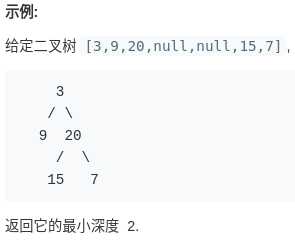标签:val front == 宽度优先搜索 图片 return 树节点 优先 bsp
题目:
给定一个二叉树,找出其最小深度。
注意最小深度的定义!
最小深度是从根节点到最近叶子节点的最短路径上的节点数量。
说明: 叶子节点是指没有子节点的节点。

一、递归法
时间复杂度:O(n)。需要遍历每一个节点。
空间复杂度:最差情况下,当一棵树是非平衡树的时候,例如每个节点都只有一个孩子,树的高度为n,会产生n次递归调用,因此栈的空间开销是O(N)。但在最好情况下,树的高度只有log(n),栈的空间开销是O(log(N))。
/** * Definition for a binary tree node. * struct TreeNode { * int val; * TreeNode *left; * TreeNode *right; * TreeNode(int x) : val(x), left(NULL), right(NULL) {} * }; */ class Solution { public: int minDepth(TreeNode* root) { if (root == NULL) return 0; if( (root->left == NULL) && (root->right == NULL) ) return 1; int depthL = INT_MAX; int depthR = INT_MAX; if(root->left != NULL) depthL = minDepth(root->left); if(root->right != NULL) depthR = minDepth(root->right); int depth = min( depthL, depthR ) + 1; return depth; } };
二、宽度优先搜索
使用FIFO的数据结构queue存储树节点,从而实现对树节点自上而下的遍历。
时间复杂度:O(N)。完全二叉树的情况下,需要对 n/2 个节点进行遍历。非平衡树的情况下,例如每个节点只有1个孩子节点,则需要遍历所有节点。
空间复杂度:O(N)。完全二叉树的情况下,queue容器中最多需要存储 n/2 个节点。非平衡树的情况下,例如每个节点只有1个孩子节点,则queue容器中最多只存储1个节点。
/** * Definition for a binary tree node. * struct TreeNode { * int val; * TreeNode *left; * TreeNode *right; * TreeNode(int x) : val(x), left(NULL), right(NULL) {} * }; */ class Solution { public: int minDepth(TreeNode* root) { if(root == NULL) return 0; queue<TreeNode*> q; q.push(root); int depth = 0; while(!q.empty()) { int len = q.size(); for(int i = 0; i < len; ++i) { TreeNode* node = q.front(); q.pop(); int num = 0; if(node->left != NULL) { q.push(node->left); num += 1; } if(node->right != NULL) { q.push(node->right); num += 1; } if(num == 0) return depth + 1; } depth++; } return depth; } };
标签:val front == 宽度优先搜索 图片 return 树节点 优先 bsp
原文地址:https://www.cnblogs.com/gdut-gordon/p/11647108.html